In Praise of Digital vs Film (UPDATED, v3)
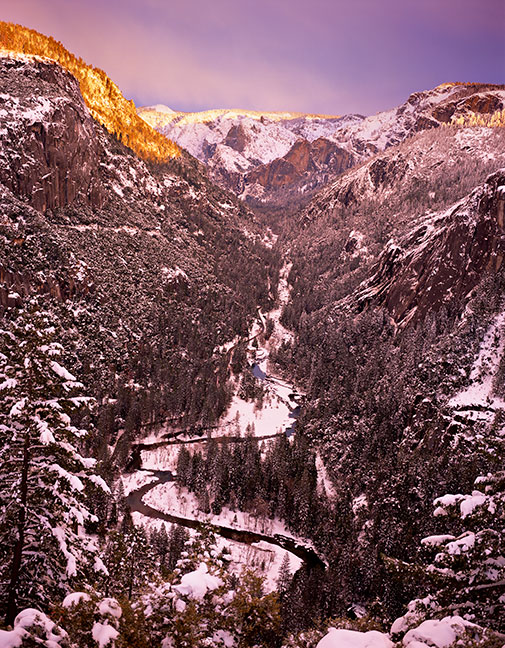
Mamiya 7 II, 150mm, f/11, Fujifilm Velvia 50
This article was reposted in 2023. See that page instead.
....
My 2013 article Photographic Film Really Was Not Much of a Performer was not well-received by those with strong cognitive commitments to the contrary, but I stand by it, because after shooting and scanning (including drum scanners) 4X5 and 6X17 and 6X7 and 35mm, it became more and more clear that alleged resolution numbers capture little about the differences, and are pretty much bullshit for real photos.
That’s not to say that top notch results were unobtainable, but you needed excellent lighting and a large format and perfect execution and not too much diffraction and pro-grade scanning. And even 6X7mm struggled to make a 30-inch print that could compete in sharpness with any of today’s ~45 megapixel cameras, or even 24MP.
Below, I was thinking about old summit climbs, and here I post a few scans from old Kodachromes. Not the best scans in this case, but the key characteristics of just how awful film was are plain to see (grain, very limited fine detail, poor dynamic range, color).
Even an iPhone could have made superior images here in many ways, though I’d want DNG for detail. I think these images were taken with a Nikon FE2 and Nikon 55mm f/2.8 Micro-Nikkor—at the time considered one of the very best lenses. Amazingly, you can still buy the Nikon 55mm f/2.8 Micro-Nikkor and it’s not cheap!
With color-reversal (slide) film in harsh shooting conditions like this, you got blown-out highlights or pinned-to-black shadows, or both. Even color negative film was hard-pressed, and unless you shot B&W film and were really careful in development... good luck. But with digital and proper exposure, I could have had excellent detail in both highlights and shadows and far superior resolution and color and barely-visible noise.
Most striking here is that these ~8-megapixel scans are visibly short on resolved detail, even while filling little more than half of my iMac 5K display.
Does that mean the images suck? Certainly not. They have their limits, but I am very glad to have made them.
Aside from hair on my head, it is astonishing was just how crappy my clothing/boots were back then. It is easy to forget how even clothing and footwear are so much better today. I still have the ice axe, though mostly it’s for digging a hole for a dump.


With the lighting right, the contrast issues were fine, as here. But detail... an iPhone could easily outperform this, albeit with ugly digital artifacts. Film probably better in this case than an iPhone for the subjective qualities.

Claude F writes:
Kodachrome was able to work with two stops of dynamic range. Fuji ASTIA six. I used 4x5 Vericolor long exposure negative film which was good for eight stops but with the corresponding, and difficult color cross over problems. Back in the day there were other options that were close to impossible to deal with. Color duplicating film with its very flat but wildly varied color balance was a tried but never fully developed experiment.
Flat bed scanning has gotten better, but is nevertheless another step in an already complicated process
I well understand the advantages of using a 4x5 camera. I also well understand the limitations of always having to work on tripod.
There is a common misconception that using film in some way slows the process of making pictures more time consuming. I spend just as much time composing a digital composition as I did using film. Digital or film has nothing to do with creating a picture, for me at least. And I could set the view camera up, focus, meter and shoot two exposures in less than two minutes. Takes less time with digital once I’m at the camera but that’s not where I spend the time needed to make a photo.
[DIGLLOYD: agreed, same finding/hiking/setup/composing time, but I myself would emphasize the ''pain' of filming into a scan, which Claude and I agree on entirely after speaking about it on the phone]In my book if someone wants to use film or numbers to record a scene that’s simply a preference. I still carefully consider the contrast range of a subject and never rely on a sensor to handle over eight stops of dynamic range.
There is a certain cachet associated with the use of film, but what is not widely known is that once the film is scanned, it becomes a digital file subject to the same post process as a digital first file. A film to wet darkroom print has no where near the ability to be changed, but still masking, burning dodging, tone scale, can be manipulated by the artist to the point where the departure from “what was there” is striking.
The bottom line for me after using a view camera and film for 30 years was that digital could finally match what I did with the view camera. And it’s not until the capabilities of the Fujifilm GFX 100s that the capability is solid with a single exposure.
DIGLLOYD: Claude’s images total maybe 10 a year shot under selective conditions, and likely not shot under the conditions most unfavorable to film. Different premises from mine.
UPDATE 2: I spoke with Claude at length (phone); we really aren’t saying anything different. And of course subject matter and its lighting can have a significant influence on the capture vs the medium. Claude’s note was never meant to be an essay to fully treat the matter (and while I asked before publishing it, it is also true that I knew it might not adequately cover his viewpoint).
The “preference” of film carries with it a heavy time and cost burden, along with very limited and expensive film choices, even ignoring developing and scanning [update: Claude had just not made that as explicit, and we are in agreement that film carries a burden with it]. And even the best scan cannot recover blown highlights or pinned shadows in 'post'. I could see shooting B&W film for its control during development, but not much else.
The bottom line for me is that in examining my best 4X5 and 6X17 and 35mm film images (10X loupe or scanned), the detail and dynamic range invariably quickly show limits. Fifteen years of digital only reinforce that impression and at 45-50 megapixels.
But the bottom line is this: show me the evidence. I have a number of Christopher Burkett prints, some up to 40X30 and shot on 8X10 film. . I’ll concede that if you shoot a 4X larger film area than 4X5 (8X 10 film), and are one of the world’s best printers taking weeks or months to get a print right, and expose in for ideal lighting with 30 years of experience nailing it... yeah you can do darn well
Example: Mamiya 7 II 6X7 film scan
Those who remember the Mamiya 7 II and its lenses know that you’d be hard pressed to find sharper optics. While a 4X5 would capture about 3.3X more area (~100 X ~127mm vs 56 X 70mm), the linear resolution increase would be about 1.8X, and it’s doubtful that the lens can deliver as much per-area sharpness over the entire 4X5 film (even assuming film flatness is perfect) as can the Mamiya lenses on 6X7 film. The gains would lessen but not close the gap.
Below (see crops), detail as scanned from oil-mounted chrome on the Tango drum scanner shows nothing remotely approaching what I would call sharp by comparison with today’s digital cameras.
Tango drum scanner: 7242 X 9294 = 67 megapixels. Actual film area of 6X7 is about 56 X 70mm.
The reduced size 3620 X 4646 = 16.8 megapixel image shown below is a size I deem disappointingly soft and yet it is a 2X linear reduction from the full-res scan! Downsampling 2X linearly for a 4X pixel reduction yields an image notably less sharp than what I would expect from even a 24 megapixel digital camera.
An image at f/8 or f/11 would have slightly better sharpness and maybe not, as depth of field might be too low for any field curvature. Plus DoF on 6X7 mandates f/16 most of the time (equivalent to f/8 on 35mm format). I’ll also grant that a lens superior to the already outstanding Mamiya optics could do a smidgen better. Both of which change nothing.
This example is a very fair example of how well you can do with film—it represents not just typical but very good results—it is in-focus at uniform distance and at the ideal aperture for the format and scene (f/11). The Mamiya lenses on 6X7 were highly respected for sharpness and do as well here as anything on 35mm. In other words, I see the same or better resolving power on a much larger piece of film than 35mm.

Mamiya 7 II, 150mm, f/11, Fujifilm Velvia 50
Below, two actual pixels crops from the full-res 67-megapixel scan. You could get aggressive on sharpening, but it’s awfully damn soft. I would rate the detail as comparable to a 16 megapixel digital camera and with far more grain.
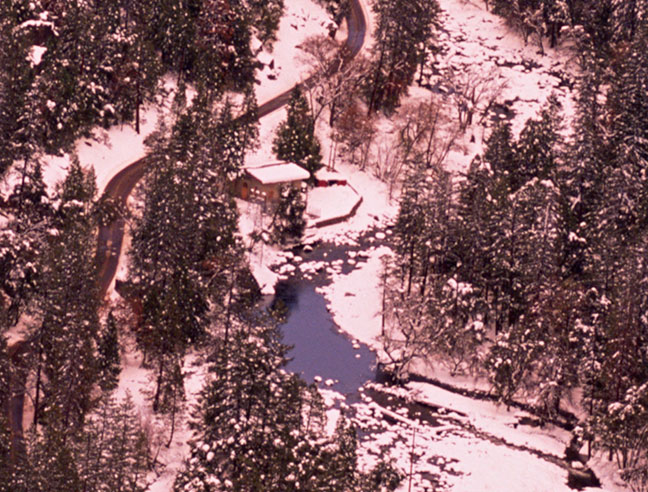
The grain in the sky is prominent, far inferior to what a 24-megapixel digital camera could deliver.
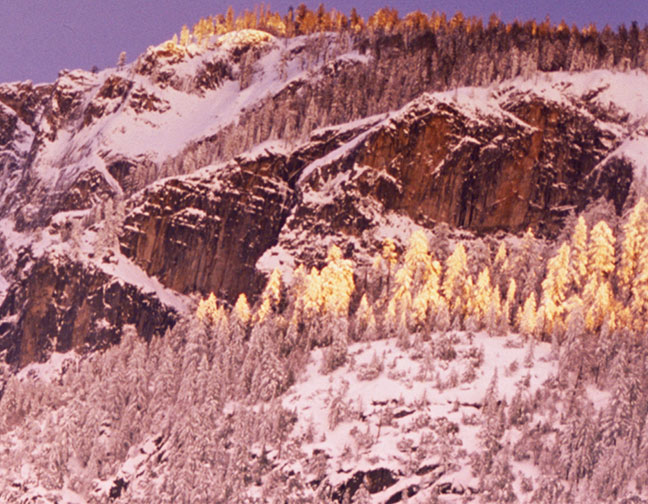
Bernd R writes:
As always an excellent analysis of this topic in your blog!
I fully agree that from an image quality point of view 6x7 is inferior to a current 45 megapixel camera when printed to 30 inch. It may however be good enough when viewed from a reasonable distance in my experience. For me, the main advantages of analog is in the process: I spend less time in front of a computer as compared to digital (thinking about mounting slides and projecting them), and the slide is authentic in the sense that the piece of film accompanied me on my adventure, and that the color rendering cannot be manipulated after the shot. Yet another advantage is that I get to use beautiful equipment (Mamiya RZ 67, Linhof Technica), which can be bought for 10 cent on the dollar used.
[Agreed on the beauty of a chrome, but slides end up in a box and de facto never get seen, over time, nor are they accessible to anyone not physically there]From a purely technical point of view, I believe it is not a fair comparison to post completely unedited scans in order to prove how bad they are - you would not post unsharpened and unedited raw files either. I took the liberty to edit two of your example files in my standard capturing work flow for scans, see attached (1-2 minutes each). They clearly are not pixel level sharp such as good digital files, but I believe they would print decently when choosing an appropriate print size.
DIGLLOYD: thoughtful notes like this and Claude’s are always appreciated.
I agree that pleasing prints from 6X7 and especially 4X5 can be made and indeed I made a goodly number from 35mm and some from 4X5 which still hang on my wall (the 4X5 ones). Which is of course different from saying they are nicely sharp.
When I review my prints from 35mm film (optical enlarger) at only 13X19 versus what I've printed off digital, they’re pretty awful in terms of sharpness and excessive grain, even the best of them. I also have several 4X5 foot prints from 4X5 chromes and they look great at moderate viewing distance and are obviously far superior to the 35mm results. But they’re still short on sharpness—I have one such print on my office wall and it looks great 6-8 feet away, but at 4 feet I start wishing I had more, because such details intrigue me vs the feel of being there—but those details and textures are lost forever.
I've also made 13X19 prints of 3 megapixels like the Nikon D2H—for portraits they are very satisfactory and better than the 35mm film images in every important way, and they look just as sharp as 35mm-film images. Not that sharp, but the brain doesn’t need a whole lot to see a face as sharp, and the sharpness was top-notch for the sensor resolution. So the specific subject matter is a real consideration too.
To establish a reference: my Sigma DP1 Merrill (14MP X true color pixels) made great-looking 4X5-foot prints than my 4X5 film images! My tulips image still hangs in the entry of my house and it competes if not beats 4X5 film very favorably.
The 6X7 above had already gotten some Smart Sharpen and Unsharp Mask, enough to properly account for the scanning process, but not the amount I’d add for printing. The sharpening Bernd R added in his reply does add some acutance and of course will look better to the eye, and I concur that I'd do that (and more) for a print. But neither hair of legs nor twigs of trees are actually there—more like a enhanced edge contrast that at best is suggestive of detail—at least 2X if not 2.5X linearly less resolved detail than I’d like to see. The small trees are particularly revealing of having no real definition—we’re not seeing the branches defined.
I liken such sharpening to iPhone JPEG/HEIC images. By strongly accentuating the acutance (de facto MTF eg contrast) of coarse and medium structures, the eye sees "sharp" at first glance. Because the eye responds first to edges of any size, and sharpness comes later and only with examination. But when I look at such iPhone images, all the fine detail is smeared away—no hair, no weave of cloth, no pine needles, no textures, blotchy skin, etc. That is why I shoot DNG with the iPhone when it matters—the difference is huge and if you’re not seeing it, you’re looking at it wrong, perhaps at reduced size and/or at Retina resolution which exceeds the human eye’s resolving power for most of us.
Rich Seiling writes:
Reading the film vs digital post with great interest. I did some testing during the WCI days that might be of interest to your readers. I’ve attached a couple quick screenshots to give you an idea. Pre digital I photographed the same scene in Yosemite with 35mm, Pentax 6x7, Hasselblad, and 4x5 with a Nikkor lens with lenses of similar view angle, roughly a 35mm focal length in 35mm format. I continued to photograph this scene with digital as time when on. Film was scanned on my Tango and some were scanned at “oversampled” resolutions. I’m willing to share more files if it is of sufficient interest. If I had to do this over, I would control more variables in regards to optimum apertures as we understand it now, so while it is a very good snapshot, it is not the absolute end all answer, if there even is such a thing.
I have given the resolution comparison of film formats and digital much thought and study, and have a draft of an article comparing film to digital resolution that remains unfinished because it is not a topic many people care about currently, but I needed to resolve some of these issues for myself.
Haven seen and made scans and prints for some of the most highly regarded photographers in the world, I have a pretty good idea what “good” film looks like and what it can do in a print. I’ve seen a lot of “average" film, as well as superb film. Few people made superb film as it requires the right equipment and intentionality, just as great results with digital does today.
As a rough ballpark that I am sure people will argue with, I believe that 4x5 film is roughly equivalent to 100-150mp based on making and comparing large prints (24x36? 30x40 for sure), not screen viewing. Film does look softer than digital on screen, but when you start making 3500spi scans of 4x5 made with good lenses, there is a lot that can be pulled out that makes very beautiful large prints.
If we accept that 100-150 mp value 40r 4x5 film, we can achieve that number of pixels with a 2300 to 2750 spi (spots per inch) scan. Using the same spi, we get the following values for other films:
8x10 423-600mp
6x7 32-46mp
6x6 26-38mp
645 21-30mp
35mm 7-10 mp
Disk film … just joking but probably 640x480There is going to be a lot of variability in the resolution of film due to lens quality, diffraction from using too small an aperture, and sloppy technique. How much data the film can hold and how much is actually transmitted to it by the lens is a much bigger delta than people want to believe.
Continues...
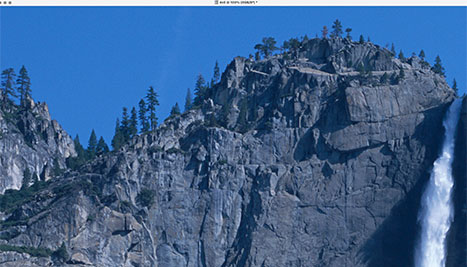 Example from Rich Seilig: 4X5 scan
Example from Rich Seilig: 4X5 scan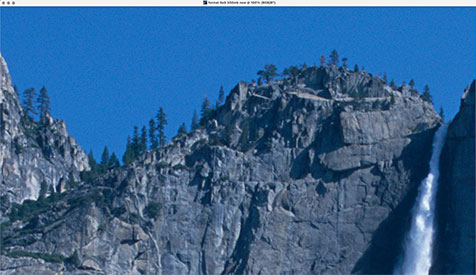 Example from Rich Seilig: 6X6 scan
Example from Rich Seilig: 6X6 scan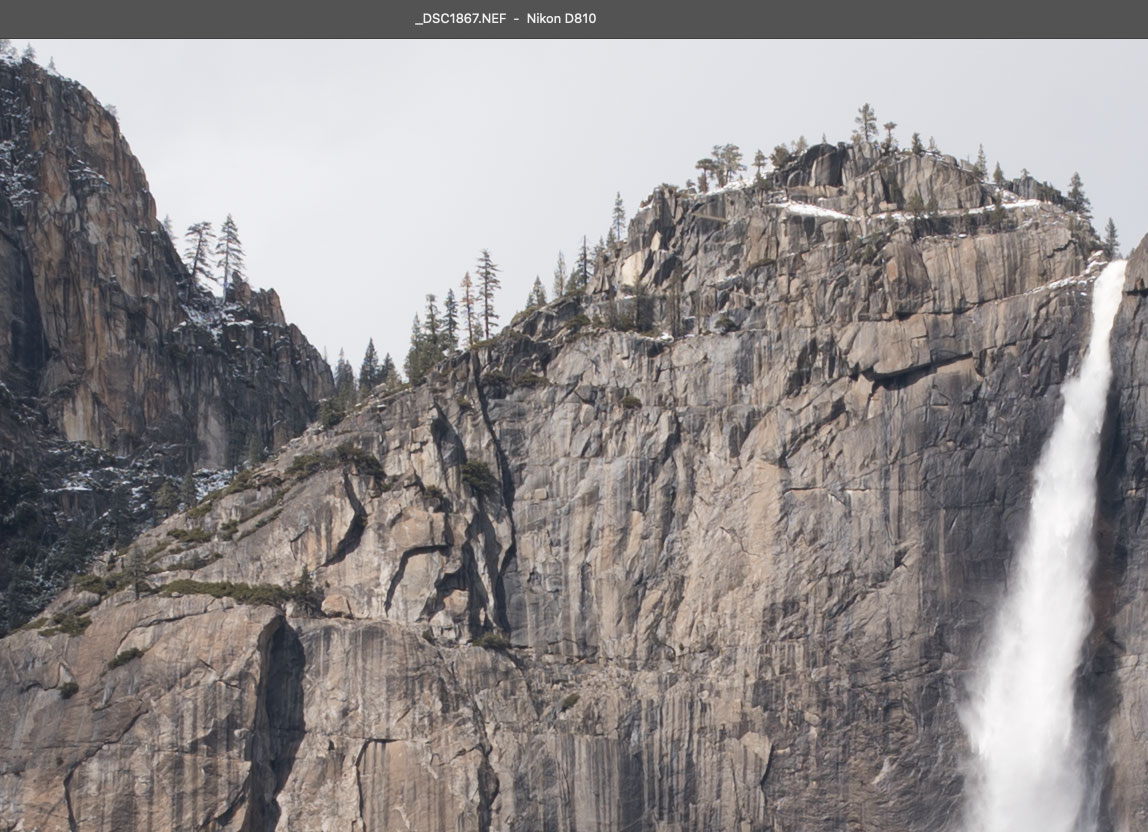 Example from Rich Seilig: Nikon D810
Example from Rich Seilig: Nikon D810As a check on these numbers, feel like the medium format numbers would be on the lower side because most medium format glass wasn’t that good. In my own test a early 1990s vintage Pentax 6x7 lens performed the same as a 1960s Zeiss lens on Hasselblad cropped to 645! Looking at countless scans over the years has reinforced that. Apart from Zeiss, the other brands were pretty average, even those held in high esteem at the time (no love for the Mamiya here.) I have a “favorite” image made on 6x7 that no way is as good as what I can do with my Sony A7RII and high end glass, so I think even 32MP is pushing it for that particular lens with 6x7 film. it’s 24mp?
I’ve also observed that prints from digital files look sharper when they provide 300ppi un-interpolated files at output size, but large format film gains an edge on larger size prints. A large scan of 4x5 can produce a 30x40 file at 300ppi with no problems and it does show some advantages there and at larger sizes. I have no hard numbers here as it is observational of a large number of prints rather than a side by side test. If making the best 30x40s was your thing, you’d want to look at 4x5 or 100MP and larger cameras, and 8x10 as well.
My personal feeling is that I would rather use a 24mp with great glass today than any MF film camera, and with 36mp cameras and above, there is no comparison. Digital solves a lot of problems the film process has which makes it easier to get better results from digital unless one is a experienced and dedicated user of large format. Furthermore, large format is plagued by focusing errors as well as imprecise use of its movements such that for 90%+ of users, they would get sharper photos from digital.
Large format film used properly is still amazing, and I’ve seen nothing in practical use that compares to 8x10 in terms of resolution. In the right light, film captures things in color I don’t see digital doing. Particularly golden hour and red sunset colors. I believe part of this is due to the color losses of the Bayer matrix and the RGB filters used, but also the IR cutoff filters cut off red light that is visible to the eye, and I have evidence that light can be recorded with cameras modified for astrophotography but goes orangish red on standard cameras. At it’s best, in the best conditions of rare, magical, fleeting light, film can record color and light in a way digital simply can’t. But that window is very small and hard to find, so for all the other times outside, digital expands the opportunities for making photographs and allows things film can’t do.
It really comes down to use what inspires you to keep photogaphing. They don’t have to be the same to justify the use of one or the other. I’m an advocate for making more pictures with whatever floats your boat. But if you are looking to achieve certain things, you do need to know their capabilities, and do your own testing.
DIGLLOYD: great info from someone with tons of experience!
I agree on the subjectivity involved, especially given the perceptual issues. For myself, I would downrate Rich’s numbers by 1/3 or so, given film behavior and grain, lens performance, film thickness, film flatnesss (particularly on 8X10 and 4X5 but also 6X17 and 6X7 formats), diffraction, depth of field (a big one!), focus errors, etc.
Lloyd’s equivalence subjective numbers:
8x10: 240 to 320 MP
4X5: 60 to 100 MP
6x7: 18 to 24 MP
645: 16 to 22 MP
35mm: 5 to 10 MP
Modern lens performance could make a 1/3 difference in the numbers, so I think numbers are defensible, though I will not insist they are “right”. Film-related drags on sharpness are high. The high number would be perfect execution at ideal aperture, the lower figure would be typical, including the requirement for stopping well down, which by f/22 is already hurting resolution very obviously (a 10X or 20X loupe proves that out).
Accepting Rich’s examples as expert-grade, I note that his 4X5 example looks pretty much like my 4X5 findings. When I upscale that Nikon D810 image to the same size as the 4X5, I can see that the 4X5 has a wee bit more detail. But it’s not persuasive, and the D810 is a 36-megapixel camera. A Sony A1 with top glass (or similar) would be awfully close, and maybe better, depending on subject matter? That argues for a 4X5 equivalence of around 50MP, which dovetails with my original claim about what the Sony A1 delivers. And what if Gigapixel AI were used on the digital image, with its ultra-low noise? I’d bet on the D810 in that case. Or what about a Panasonic S1R in multi-shot high-res mode?
And it’s not like you can easily focus stack with film—game over in massive favor of digital whenever DoF get involved—the elephant in the room by far.
Shown below, I took a fresh look at one of my sharpest 40 X 50 inch prints from 4X5, shot using the Rodenstock 135mm f/5.6 APO-Sironar-S on Fufjilm Velvia 50. I think it was at f/22, but I'm not certain. It is acceptably sharp at a viewing distance of two feet (too close for normal viewing)—not crisp but pretty good. Scanned on an Imacon Flextight at ~1880 ppi at 9429 X 7507 = 70.7 megapixels. A better scan could be done, but the scan at this resolution already suggests that most of the real detail has been captured. Still, perhaps a bit more could be extracted such that a large print would benefit in nuanced ways. And maybe that could slightly modify my figures above.
The image is pleasing and it hangs on my office wall, but it lacks the crispness that I am certain I could get with the Fujifilm GFX100, so what does that tell us?
I would therefore argue for a subjective perceived sharpness value of 60 to 80 megapixels for 4X5 as a typical achievable value, but often as low as 50 megapixels. That scan is 70 megapixels and falls right into that range, and I would not call it very sharp, were it a digitally-shot image. Would oversamping the chrome at 100 or 140 or 200 megapixels reveal meaningful detail such that it could be claimed to be 100 megapixels? Perhaps, but I am doubtful because I don’t think the scanning ppi is a signficant gating factor here.
Rich Seiling writes in response:
And I think your evaluations are within the ballpark too. I’m erroring on the higher end, but I think that in most cases the lower value is more accurate for must camera/lens situations. And oversampling when scanning makes a difference too. Scanning a 4x5 at 2500spi vs 3500spi leads to about a 25% increase in apparent sharpness as the higher spi scan resolves the grain more clearly, which I have confirmed with multiple tests.
I have another scene shot with 4x5 and a 90mm voitlander on the D810 that I have printed to 30x40 and had very experienced viewers (my staff at WCI and a few photo friends) try to pick which was 4x5. The 4x5 users picked the 4x5 print and the smaller format users picked the D810 print. The D810 print had sharper edges, which is a strength of digital but the not edge detail was not as sharp. The 4x5 edges were a little more diffuse but it hat the appearance of more detail in non edge areas. Part of this was real I thin, but part is also induced by the grain of the film as I have observed many times that grain can create the appearance of sharpness. Neither were shot at the optimum aperture and suffer from more diffraction than I would consider acceptable now. But for most users, even 36mp cropped to 4x5 was giving 4x5 a good run. The differences at 50mp+ would become even smaller, particularly with very careful sharpening.
DIGLLOYD: sharper grain isn't necessarily more than a marginally sharper image, but I agree it could help some, particularly in the feel of the image and suggestive sharpness. Grain can make things look sharper to the eye... would be an interesting 3rd test if "Add Noise" was done to the digital variant—probably would look sharper!
Bottom line that everyone is agreing on is that digital is awfully impressive, even if all you can use is "only" 35mm format. Excepting 8X10 film perfectly executed, I would say that current and future medium format cameras have let film far behind.
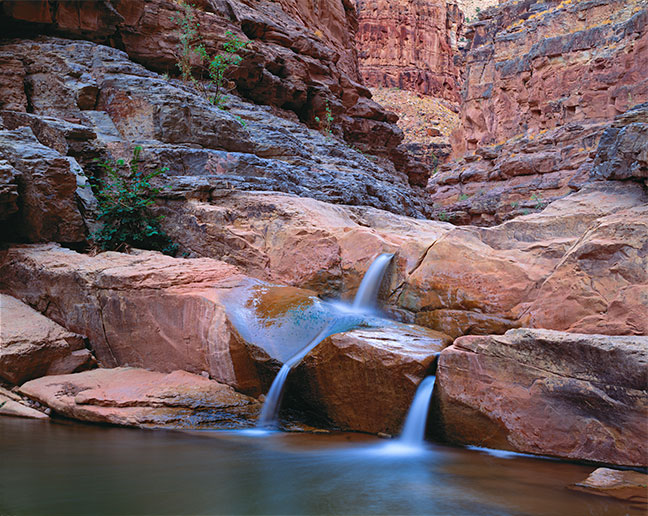
Depth of field is a factor in this shot. Good dose of Unsharp Mask wide radious contrast enhancement along with .























